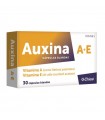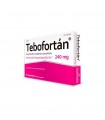- Acetaminophen is a derivative of para-aminophenol, with analgesic and antipyretic activity.
* Analgesic effect. Its mechanism of action is not fully clarified, but it appears to be mainly mediated by inhibition of cyclooxygenase at the central level, especially COX-2, decreasing the synthesis of prostaglandins. It also has some peripheral effect when blocking the generation of painful nerve impulse. There is also a possible peripheral effect by inhibition of prostaglandin synthesis, activation of the CB1 cannabinoid receptor, modulation of serotonergic or opiate signaling pathways, inhibition of nitric oxide synthesis or hyperalgesia induced by substance P.
* Antipyretic effect. It acts on the hypothalamic thermoregulatory center, inhibiting the synthesis of prostaglandins and the effects of endogenous pyrogen, resulting in peripheral vasodilation, increased blood flow to the skin and increased sweating, which contribute to heat loss.
At equal dose it is considered to have an analgesic and antipyretic potency similar to acetylsalic acid (AAS). The effects are maximum at 1-3 h and last for 3-4 h.
Unlike AAS and other NSAIDs, it does not have appreciable anti-inflammatory activity, except in some non-rheumatic pathologies, although it is not important. An advantage over NSAIDs is that not only does it not inhibit the synthesis of prostaglandins at the gastric level, but it seems to increase it, so it does not result in gastrolesive effects. Similarly, it lacks antiplatelet effects.
- Although it does not significantly reduce inflammation, very positive effects have been obtained in arthritic knee processes, probably due to its analgesic effect.
- Monitoring:
* Renal functionality and blood count in patients treated for extended periods of time.
* Liver functionality at baseline and on a regular basis in patients at high risk of hepatotoxicity.
A reduction in elimination has been reported in elderly patients. Certain manufacturers recommend decreasing the dose by 25% for young adults, but others do not consider this precaution necessary.
- It can be taken with or without food. Food-free administration accelerates analgesic effects, but not their intensity.
- Do not exceed recommended doses or use for more than 10 days without being recommended by a doctor. Stop treatment as soon as symptoms go away.
- Consult your doctor and/or pharmacist if the pain continues after 5-10 days of treatment (3-5 days in children; 2 days in case of pharyngeal pain), fever lasts for more than 3 days, or symptoms worsen or new ones appear.
- Patients who routinely consume alcohol in significant amounts (3 or more drinks daily) should limit doses of acetaminophen to prevent liver damage.
- In case of overdose, consult with a doctor and/or pharmacist, even if no symptoms appear.
- Severe and active liver disease.
Animal safety: in terms of ibuprofen, no teratogenic effects have been reported, but fetal damage has been reported on important occasions, as well as involvement of childbirth.
Safety in humans: there are no adequate and well-controlled studies in humans. Dolostop Plus is not recommended during the first and second trimesters. Its use is contraindicated during the third trimester.
* Ibuprofen: Inhibition of fetal prostaglandin synthesis during the first two gestational trimesters has been associated with an increased risk of abortion, cardiac malformations (up to 1.5% more than placebo) and gastroschisis. The risk appears to be increased with high doses and prolonged treatments.
On the other hand, chronic use during the third trimester could theoretically result in premature closure of the fetal arterious ductus and fetal renal dysfunction at risk of oligohydroamniosis. In addition, due to its antiplatelet effects, bleeding time may be prolonged, with possible fetal involvement and risks in childbirth. Another possible effect that could occur is the reduction and even cancellation of uterine contractility, causing an abnormal delay in childbirth and a non-physiological prolongation of gestation.
It is not known whether timely administration of an NSAID could pose a fetal risk.
The use of ibuprofen during the first two trimesters of pregnancy is only accepted in the event that there are no safer therapeutic alternatives, the benefits outweigh the potential risks. If used, it will be done at the lowest possible dose and for the shortest possible time. The use of an NSAID in the third trimester is contraindicated.
* Paracetamol:
Acetaminophen crosses the placental barrier. Several cohort studies have been conducted on the safety of acetaminophen orally in pregnant women. These studies did not see an increased risk of congenital malformation, heart defects or miscarriage. There is evidence that their employment over the past two quarters could be related to an increased risk of wheezing in the child's first year of life.
Some specific cases of serious adverse reactions have been reported in children of mothers receiving acetaminophen during pregnancy, including severe anemia, hepatotoxicity and nephrotoxicity (the latter two fatal). However, these symptoms appeared to be due to an overdose by the mother.
Oral acetaminophen, at recommended doses and used on time, is considered a safe analgesic/antipyretic during pregnancy. It has been used just before delivery in women with secondary fever to chorioamnionitis, with a significant improvement in fetal and newborn status, following normalization of maternal temperature. However, its use at high doses or for longer periods of time could be related to fetal hepatotoxicity phenomena.
On the contrary, due to the absence of safety and efficacy data in pregnant women, it is recommended to avoid parenteral use, unless the expected benefits outweigh the potential risks.
Effects on fertility: in animal trials, acetaminophen resulted in testicular atrophy and decreased spermatogenesis at high doses. It is not known whether this data can be extrapolated to humans. As for ibuprofen, there are no specific human studies.
Oral, parenteral, rectal route:
- Absorption: therapeutic cp is about 10 mcg/ml.
- [PAIN]. Symptomatic treatment of mild to moderate intensity pain, such as:
* [CEFALEA].
* [ODONTALGIA].
* [DYSMENORRHEA].
* [OSTEOMUSCULAR PAIN] such as [MUSCLE CONTRACTURE], [TORTICOLIS], [LUMBALGIA], [ARTROSIS] or [RHEUMATOID ARTHRITIS].
* [NEURALGIA] as [CIATICA].
* Sore throat.
* Postoperative or postpartum pain.
- [FIEBRE]. Symptomatic treatment of feverish state.
In general, interactions with acetaminophen are not expected to be severe due to their timely use. Only in patients treated with high doses, especially if there are other risk factors for hepatotoxicity, or in long-term treatments is it to be expected that interactions will have clinical significance.
- NSAIDS. Acetaminophen is commonly used in combination with other pain relievers, such as ibuprofen, for the treatment of febrile processes in children However, it should be noted that its administration together with NSAIDs or salicylates at high doses and for extended periods of time could increase the risk of kidney damage. It is therefore recommended not to exceed the recommended doses and limit the joint treatment to the minimum indispensable.
- Oral anticoagulants. Unlike NSAIDs and acetylsalic acid, acetaminophen has no antiplatelet activity or affects blood clotting per se, which is why it is used as an analgesic drug of choice in patients treated with oral anticoagulants.
However, in case of prolonged treatments and at high doses, but without entering toxic doses, a slight hepatotoxic effect could occur, characterized by decreased production of liver coagulation factors, so the INR of these patients, with risk of bleeding, could be increased.
Therefore, it is recommended to monitor this parameter in these patients treated with high doses. The risk seems negligible in case of specific treatments or in prolonged treatments with doses < 2 g/24 h.
- Busulfan. Risk of busulfan toxicity by reducing acetaminophen levels of glutation, a substance with which busulfan is conjugated in its elimination. It is recommended to avoid administration of acetaminophen, or limit exposure if not possible, within 72 hours before and during treatment with busulfan.
- Chloanfenicol. Acetaminophen may promote the accumulation of chloranfenicol by decreasing your liver metabolism, at risk of haematological toxicity. It is advisable to monitor the patient.
- Drugs that delayed gastric emptying, such as anticholinergic or exenatide. This delay could slow the absorption of acetaminophen and the onset of the effect, steady than its intensity.
- Hepatotoxic drugs. High-dose acetaminophen exerts a hepatotoxic effect. It is recommended to avoid joint administration with other hepatotoxic drugs, as well as alcohol.
- Enzyme inducers (estrogenic oral contraceptives, barbiturates, carbamazepine, phenytoin, rifampicin). Acetaminophen is partially metabolized by cytochrome P450, so its plasma levels and therapeutic effects may be reduced in case of administration along with a potent inducing drug of the liver microsomal system. On the other hand, in case of overdose by acetaminophen, the inducer could increase liver toxicity as a result of increased production of toxic metabolites generated by this enzyme system.
- Enzyme inhibitors (imatinib, isoniazid, propranolol). Increases in plasma levels of acetaminophen by drugs with activity inhibiting their metabolism have been reported.
- Reverse transcriptase inhibitors (didanosine, zidovudine). Acetaminophen may enhance the haematological toxicity of zidovudine. On the other hand, both didanosine and zidovudine could promote hepatotoxicity by acetaminophen.
- Lamotrigin. Paracetamol could increase the metabolism of lamotrigin, reducing its therapeutic effects.
- Ion exchange resins (cholestyramine, colestipol). Possible decrease in acetaminophen absorption. Distance management by an hour.
Studies have shown the absence of significant pharmacokinetic interaction with adefovir, amantadine, H2 antihistamines or proton pump inhibitors, argatrobán, chloroquine, erythromycin, lithium, methotrexate, oseltamivir, sucralfate, telmisartan or zolmitriptan. No interaction of any kind has been reported with alpha-1 adrenergic blockers (doxazosin, terazosin), furosemide, letrozole or zanamivir.
Acetaminophen slightly reduces urinary excretion of diazepam, although plasma levels remain unchanged.
Acetaminophen does not affect the immunogenicity of influenza vaccines, and may reduce the symptomatology of influenza adverse reactions.
Acetaminophen is excreted in small amounts with breast milk, reaching milk concentrations of 10-15 mcg/ml (similar to plasma) after 1-2 h after a dose of 650 mg p.o. Exposure in the child is estimated at 1-2% of the maternal dose. No acetaminophen or its metabolites have been found in the urine of the infant, nor have adverse reactions been reported in the child, except for a case of maculopapular rash, which was resolved without sequelae when the mother discontinued acetaminophen.
The American Academy of Pediatrics and the World Health Organization consider acetaminophen compatible with breastfeeding.
Acetaminophen is an analgesic-antipyretic drug commonly used in children, including young children. However, as a general precautionary measure, its use in children under 3 years of age should be carried out under control , and limit its use to the minimum possible.
Due to the potentially fatal risks of serious poisoning, close monitoring of dosing in children is recommended, avoiding doses higher than recommended. In this way, the appropriate presentation should be used to precisely dose the child, depending on his weight.
It is advisable to consult the dosage of the different presentations for more information on their use in children.
Acetaminophen can be taken with or without food. However, oral fasting accelerates the effects of acetaminophen, but not its intensity.
If a faster effect is required, it is recommended to take without food.
It is recommended to avoid doses greater than 2 g/24 h (orally) or 3 g (i.v.), with a minimum interval of at least 8 h.
Orally:
- CLcr 50-90 ml/min: no dose readjustment required.- CLcr 10-50 ml/min: 500 mg/6 h.- CLcr < 10 ml/min: 500 mg/8 h.- [RENAL INSUFFICIENCY]. Patients treated with high doses for long periods of time may experience renal adverse reactions, so monitoring of renal functionality is recommended. Patients with end-stage renal impairment (CLcr < 10 ml/min) should distance the intakes by at least 8 hours. No special problems are expected in case of punctual use.
- [HEPATOTOXICITY]. Hepatotoxic compounds such as N-acetyl-benzoquinone imina are generated during acetaminophen liver metabolism. This compound is produced in small amounts through cytochrome P450 metabolism, a minority route for acetaminophen. However, at high doses of acetaminophen, saturation of the fundamental routes (glucuron and sulfateconjugation) may occur, increasing the role of this cytochrome, and the consequent production of benzoquinone. This substance is rapidly detoxified with reduced glutation expenditure, transforming into cysteine and mercapteric acid, being eliminated by urine. If benzoquinone production is excessive, glutation depletion occurs in the hepatocyte, and consequent cellular damage, which could lead to life-threatening toxicity. This hepatotoxicity is a delayed adverse reaction, symptoms usually appear within 2 days of overdose and are maximum at 4-6 days.
In general, self-medication should be limited, and acetaminophen should not be used for more than 10 days without medical advice, and provided that the symptoms that motivated its use persist. It is also not advised to exceed the recommended daily doses of 4 g in adults or 60 mg/kg in children.
Due to its hepatotoxic effects, and taking into account its indications and the alternative of other analgesics and antipyretics, it is generally recommended to avoid use in patients with liver disease, including [HEPATICA INSUFFICIENCY], [HEPATITIS] or [CIRROSIS HEPATICA], as well as in patients with other risks of liver damage, such as [CRONICO ALCOHOLISM], [HIPOVOLEMIA], [DEHYDRATION] or [DEHYDRATION] with low levels of glutation , or treated with other hepatotoxic drugs.
In patients where this is not possible, it is suggested to use it in medical discretion, following a careful assessment of the benefit/risk ratio. It is recommended to evaluate liver functionality in these patients at the start of treatment and periodically throughout treatment. Similarly, the maximum doses to be used should not exceed 2 g/24 h (e.g.) or 3 g/24 h (i.v.).
- Salicylate allergy: Patients allergic to acetylsalic acid usually do not have cross-hypersensitivity reactions with acetaminophen. However, cases of mild bronchospasm have been reported in patients allergic to aspirin treated with acetaminophen.
- [SANGUINEAS DISCRASIAS]. Acetaminophen has been linked to haematological alterations such as [LEUCOPENIA], agranulocytosis or [NEUTROPENIA]. Periodic blood counts may be necessary for prolonged treatments.
- Determination of pancreatic functionality. Acetaminophen can interfere with the bentiromide test, because it is metabolized to arilamine, resulting in a false increase in para-aminobenzoic acid. It is recommended to stop taking acetaminophen at least three days before the test.
- This medicine contains lactose. Patients with hereditary or gactose [LACTOSE INTOLERANCE], Lapp lactase insufficiency or glucose or galctose malaabsorption should not take this medicine.
Acetaminophen is usually well tolerated, and its adverse reactions are rare.
Adverse reactions are described according to each frequency interval, considered very common (>10%), common (1-10%), uncommon (0.1-1%), rare (0.01-0.1%), very rare (<0.01%) or of unknown frequency (cannot be estimated from the available data).
Symptoms: Acetaminophen can lead to very serious and life-threatening poisoning. Toxicity may begin to be experienced from single doses of 6 g in adults or 100 mg/kg in children. Dosages greater than 20-25 g are potentially fatal. Chronic doses greater than 4 g/24 h may result in transient hepatotoxicity. However, patients treated with other hepatotoxic drugs, enzyme inducers or chronic alcoholism may be more susceptible to their toxic effects, requiring lower doses to produce toxicity.
Hepatotoxicity may occur at acetaminophen Cp greater than 120 mcg/ml at 4 h and 30 mcg/ml at 12 h. Levels of 300 mcg/ml at 4 h of overdose have been linked to hepatotoxicity phenomena in 90% of patients.
Acetaminophen overdose follows four characteristic clinical stages:
- Phase I: appears within a few hours of overdose, and until the first 24 hours. Take with general discomfort, nausea and vomiting, abdominal pain, paleness, excess sweating and anorexia. Liver functionality and liver parameters are normal.
- Phase II: occurs at 24-36 h after overdose. Symptoms of liver damage, such as abdominal pain, begin to appear in the right hypochondrium and increased levels of transaminase and bilirubin, and prothrombin time.
- Phase III: occurs at 72-96 h after overdose, and coincides with the peak of hepatotoxicity, transaminase elevations of up to 10,000 U/l and even higher, increases in bilirubin, glucose, lactate and phosphate, as well as elevation of prothrombin time. The patient may develop encephalopathy and coma. Renal tubular necrosis and myocardial involvement have sometimes been reported. Death from fulminant hepatic impairment with hepatic necrosis may occur.
- Phase IV: occurs 7-8 days after overdose. Recovery of those patients who have survived the previous stage.
The risk of severe acetaminophen poisoning depends on the route of administration as well as the conditions of use of the drug. In this way, serious poisoning is not expected in case of overdose with suppositoriums (yes by ingestion of them, although this is not common), or in case of injectables (due to their hospital use, with health control , even though there have been serious poisonings due to confusion of the dose in the amount of acetaminophen or volume of the solution for injection). However, under no circumstances can it be ruled out.
Treatment: in case of overdose orally, and preferably within 4 h after ingestion, gastric aspiration and washing will be carried out, together with administration of active charcoal, reducing the absorption of acetaminophen.
N-acetylcysteine is the specific antidote for acetaminophen overdose. N-acetylcysteine may be used orally in adults and parenterally in adults and children.
- Via i.v.: the dose to be administered is 300 mg/kg, over a period of 20 hours and 15 minutes, according to the following guideline:
* Adults: initially 150 mg/kg (equivalent to 0.75 ml/kg 20% aqueous solution, with pH 6.5) via slow or diluted i.v. in 200 ml of 5% glucose serum, for 15 min.
Then 50 mg/kg (0.25 ml/kg 20% aqueous solution, with pH 6.5) diluted in 500 ml of glucose serum 5% in the form of an infusion i.v. for 4 h.
Finally 100 mg/kg (0.50 ml/kg 20% aqueous solution, with pH 6.5) diluted in 1,000 ml of glucose serum 5% as an infusion i.v. for 16 h.
* Children: the same guideline will be administered, although the volume of infusion solutions will be adjusted to the child's age and weight to avoid pulmonary vascular congestion.
The efficacy of parenteral treatment with N-acetylcysteine is maximum when administered within 8 hours after overdose, gradually reducing from then until ineffective at 15 h.
Administration of N-acetylcysteine may be discontinued when plasma levels of acetaminophen are less than 200 mcg/ml.
- Oral route (adults only): initially 140 mg/kg, followed by 17 doses of 70 mg/kg/4 h. The dose should be diluted in water, cola drinks or orange or grape juice up to a final concentration of 5%, as it has an unpleasant taste and can lead to irritation or sclerosing. In case of vomiting the dose within 1 h, its administration will be repeated.
If necessary, diluted in water will be administered through a duodenal tube.
If the patient experiences symptoms of hepatotoxicity, liver function should be monitored every 24 hours.




























